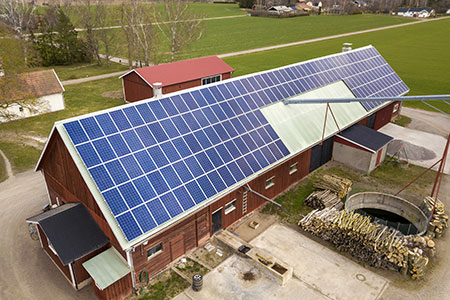Save the Earth with a Roof
A typical asphalt shingle roof lasts about twenty years. Most homeowners will need to replace their roof shingles at some point. A roof deteriorates over time after exposure to elements such as wind, rain, sun, and snow. Many materials are available that will not only outlast traditional asphalt shingles but are also eco-friendly. While eco-friendly materials are often more expensive than asphalt shingles, eco-friendly roofs last two to three times longer. Additionally, an eco-friendly roof may be enough to qualify for lower home insurance rates. They also add value to the home while promoting sustainability. Contact a local Beaverton contractor today to get started!
Eco-friendly Roofing Materials
Metal
Metal roofs can last up to fifty years. While some metal roofing doesn’t come from recycled materials, the roof is recyclable at the end of its life, which reduces waste. Metal roofs are incredibly durable. They also aid in fire-resistance. Metal roofs are perfect for collecting rainwater for gardening or other household uses. In snowier climates, metal roofs provide an advantage because they allow snow to slide off. Metal roofs prevent damage from ice dams and excess weight. Snow bars need to be installed in snowier climates to protect walkways from sliding snow, which can cause injury. If a metal roof sounds ugly or doesn’t “go” with the rest of the home, consider purchasing metal shingles designed to look like wood or slate.
Wood
Wood roofs last fifteen to twenty years. Not only can wood shingles be repurposed after the life of the roof, but the original materials are often recycled and reclaimed materials. Additionally, wood roofs are famous for their “natural” look. Wood roofs are an excellent option for the environmentally-conscious homeowner.
White Glue and White Gravel
“Cool” roofs, also known as white roofs, are popular in warmer climates. Made from a combination of white glue and white gravel, “cool” roofs reflect sunlight and reduce the need for air conditioning. Cool roofs make homes more energy-efficient, especially in the summer.
Plants
A study conducted by the National Research Council of Canada shows that living or “green” roofs as thin as six inches can reduce energy consumption by 75%. Additionally, living roofs can absorb up to Green roofs are an excellent option for urban homes, as they reduce the urban heat island effect. In congested metropolitan areas, heat can become trapped as a result of pollution and enclosed spaces. Additionally, living roofs look fantastic and will undoubtedly improve the overall aesthetic of the house. For those with small yards or no place to garden, a living roof is a convenient way to add greenery to a living space.
Rubber
Rubber shingles are made from recycled materials, usually tires and sawdust. They are also often cheaper than traditional asphalt shingles. They last much longer due to their resistance to water and wind. Additionally, rubber roofs have an easy installation process. They don’t need to be maintained as often as asphalt roofs. Additionally, rubber shingles are made to resist bending and come in a plethora of colors. While rubber roofs are a good option for weather-conscious homeowners, they are not the best option for fire-resistance.
Clay
Clay tiles are an utterly recyclable roofing material. Similar to “cool” roofs, clay tiles reflect sunlight and are very durable. Clay tiles help insulate the home in both winter and summer months, and a clay roof is a popular option for homes in desert climates. Not only do these roofs make the house more comfortable, but they reduce energy use, which helps the planet and the wallet.
Slate
Slate is one of the most durable materials used for roofs. Some manufacturers even offer a 100-year warranty on their slate roof products. The longevity of the roof’s life reduces waste, and it’s possible to find salvaged tiles, making slate an eco-friendly option that looks great, too.
Solar Cells
Large solar panels are expensive, but small solar cells can be inserted into traditional roofing materials to offset power usage with solar energy. This technology is also known as “building integrated photovoltaic technology.” Solar cells are an expensive option, but reduced energy use makes them an eco-friendly choice that saves homeowners on electricity costs.
Recyclables
The most eco-friendly option for roofing is the use of entirely recycled materials, whether they consist of wood, rubber, slate, clay, concrete, or traditional asphalt. Recycled roofs are trendy as they are durable and usually come with 50-year warranties. Some recycled roofing materials can also qualify the homeowner for reduced insurance rates due to their fire ratings. Recycled roofing reduces waste and lowers both energy use and pollution.
The Next Step in Your Eco-Friendly Roof Construction
The right eco-friendly roof is different for everyone. Climate, budget, and aesthetics all contribute to the decision-making process, and homeowners should check warranties, fire ratings, and storm ratings before deciding on the appropriate materials. Also, it’s critical to ensure that all applicable and proper permits and approvals are obtained before construction starts on the new roof. Some materials may not be allowed or approved in certain areas due to building codes or homeowner association rules. After deciding on a roofing material, a homeowner should contact a reputable roofer for a quote. Roofing is dangerous due to heavy objects and heights, so only experienced contractors should replace or install a roof. Additionally, a homeowner should never attempt to replace a roof on their own and should work with a partner, even if they are an expert in the industry.
